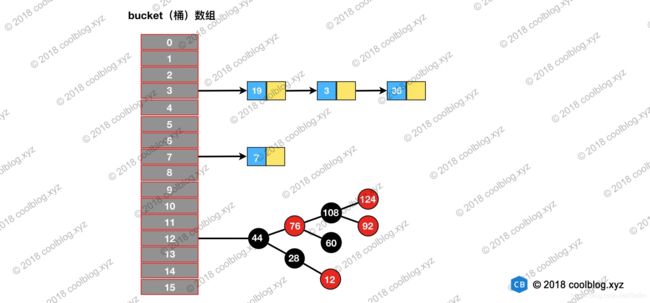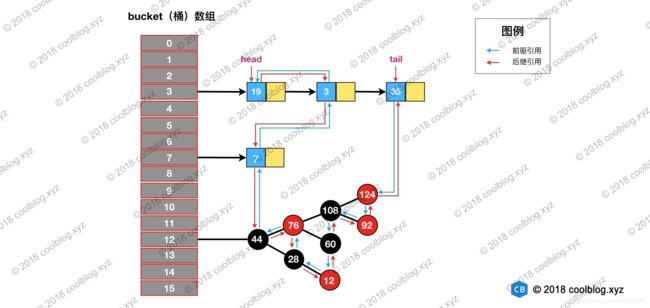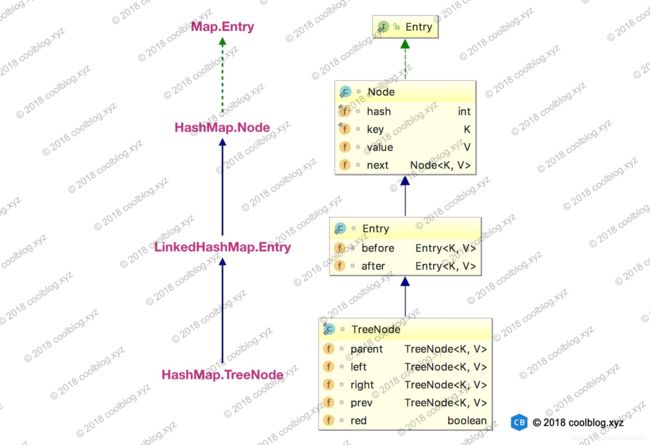Java集合类详解(5) -- 基于JDK1.8的LinkedHashMap详解
LinkedHashMap是在HashMap的基础上构建的,若我们需要按照元素插入的顺序来访问元素,相信此时LinkedHashMap能够做到HashMap做不到的事。
已知HashMap的内部结构为数组 + 单链表 + 红黑树

LinkedHashMap会在HashMap的基础上,在内部维护一个双向链表,用于访问元素,其结构为数组 + 单链表 + 红黑树 + 双向链表.

LinkedHashMap的定义
public class LinkedHashMap<K,V> extends HashMap<K,V> implements Map<K,V>
LinkedHashMap继承了HashMap!LinkedHashMap继承了HashMap!LinkedHashMap继承了HashMap!重要的事情说三遍,LinkedHashMap实际上是在HashMap的基础上扩展的。
LinkedHashMap的属性
//内部结构
static class Entry<K,V> extends HashMap.Node<K,V> {
Entry<K,V> before, after;
Entry(int hash, K key, V value, Node<K,V> next) {
super(hash, key, value, next);
}
}
// 链表头结点
transient LinkedHashMap.Entry<K,V> head;
// 链表尾结点
transient LinkedHashMap.Entry<K,V> tail;
// 访问顺序
final boolean accessOrder;
我们来讲讲访问顺序,默认情况下,LinkedHashMap 是按插入顺序维护链表。不过我们可以在初始化 LinkedHashMap,指定 accessOrder 参数为 true,即可让它按访问顺序维护链表。若我们选择了访问顺序,当我们访问元素时,需要将被访问的节点移动到链表的尾部。
Entry 的继承体系
分析键值对节点的继承体系对我们讲解下面内容是有帮助的,我们来看继承体系结构图,相信可以一目了然

LinkedHashMap的构造函数
public LinkedHashMap() {
super();
accessOrder = false;
}
public LinkedHashMap(int initialCapacity,float loadFactor,boolean accessOrder) {
super(initialCapacity, loadFactor);
this.accessOrder = accessOrder;
}
此构造函数可以控制访问顺序
LinkedHashMap的操作
插入函数
Map 类型的集合类是通过 put(K,V) 方法插入键值对,LinkedHashMap 本身并没有覆写父类的 put 方法,而是直接使用了父类的实现。但在 HashMap 中,put 方法插入的是 HashMap 内部类 Node 类型的节点,该类型的节点并不具备与 LinkedHashMap 内部类 Entry 及其子类型节点组成链表的能力,那LinkedHashMap是怎么做的呢?下面让我们走进代码
//hash(key)就是上面讲的hash方法,对其进行了第一步和第二步处理
public V put(K key, V value) {
return putVal(hash(key), key, value, false, true);
}
/**
*
* @param hash 索引的位置
* @param key 键
* @param value 值
* @param onlyIfAbsent true 表示不要更改现有值
* @param evict false表示table处于创建模式
* @return
*/
final V putVal(int hash, K key, V value, boolean onlyIfAbsent,
boolean evict) {
Node<K,V>[] tab; Node<K,V> p; int n, i;
//如果table为null或者长度为0,则进行初始化
//resize()方法本来是用于扩容,由于初始化没有实际分配空间,这里用该方法进行空间分配,后面会详细讲解该方法
if ((tab = table) == null || (n = tab.length) == 0)
n = (tab = resize()).length;
//注意:这里用到了前面讲解获得key的hash码的第三步,取模运算,下面的if-else分别是 tab[i] 为null和不为null
if ((p = tab[i = (n - 1) & hash]) == null)
tab[i] = newNode(hash, key, value, null);//tab[i] 为null,直接将新的key-value插入到计算的索引i位置
else {//tab[i] 不为null,表示该位置已经有值了
Node<K,V> e; K k;
if (p.hash == hash &&
((k = p.key) == key || (key != null && key.equals(k))))
e = p;//节点key已经有值了,直接用新值覆盖
//该链是红黑树
else if (p instanceof TreeNode)
e = ((TreeNode<K,V>)p).putTreeVal(this, tab, hash, key, value);
//该链是链表
else {
for (int binCount = 0; ; ++binCount) {
if ((e = p.next) == null) {
p.next = newNode(hash, key, value, null);
//链表长度大于8,转换成红黑树
if (binCount >= TREEIFY_THRESHOLD - 1) // -1 for 1st
treeifyBin(tab, hash);
break;
}
//key已经存在直接覆盖value
if (e.hash == hash &&
((k = e.key) == key || (key != null && key.equals(k))))
break;
p = e;
}
}
if (e != null) { // existing mapping for key
V oldValue = e.value;
if (!onlyIfAbsent || oldValue == null)
e.value = value;
afterNodeAccess(e);
return oldValue;
}
}
++modCount;//用作修改和新增快速失败
if (++size > threshold)//超过最大容量,进行扩容
resize();
afterNodeInsertion(evict);
return null;
}
在我之前的文章介绍过,这是HashMap 的插入操作,但LinkedHashMap并没有重写该函数,而是重写了一部分内部函数
//HashMap的实现
Node<K,V> newNode(int hash, K key, V value, Node<K,V> next) {
return new Node<>(hash, key, value, next);
}
//LinkedHashMap的实现
Node<K,V> newNode(int hash, K key, V value, Node<K,V> e) {
LinkedHashMap.Entry<K,V> p =
new LinkedHashMap.Entry<K,V>(hash, key, value, e);
// 将 Entry 接在双向链表的尾部
linkNodeLast(p);
return p;
}
linkNodeLast
private void linkNodeLast(LinkedHashMap.Entry<K,V> p) {
LinkedHashMap.Entry<K,V> last = tail;
tail = p;
if (last == null)
head = p;
else {
p.before = last;
last.after = p;
}
}
linkNodeLast用于在双向链表尾部插入新节点
LinkedHashMap的newNode函数与HashMap 相比,增加了对双向链表的操作
我们之前讲过,下面两个方法在HashMap是空实现
void afterNodeAccess(Node<K,V> p) { }
void afterNodeInsertion(boolean evict) { }
但是为了维护双向链表,LinkedHashMap重写了这两个方法
void afterNodeAccess(Node<K,V> e) {
LinkedHashMap.Entry<K,V> last;
if (accessOrder && (last = tail) != e) {
LinkedHashMap.Entry<K,V> p =
(LinkedHashMap.Entry<K,V>)e, b = p.before, a = p.after;
p.after = null;
if (b == null)
head = a;
else
b.after = a;
if (a != null)
a.before = b;
else
last = b;
if (last == null)
head = p;
else {
p.before = last;
last.after = p;
}
tail = p;
++modCount;
}
}
该方法将节点e转移到双向链表的末尾
void afterNodeInsertion(boolean evict) {
LinkedHashMap.Entry<K,V> first;
// 根据条件判断是否移除最近最少被访问的节点
if (evict && (first = head) != null && removeEldestEntry(first)) {
K key = first.key;
removeNode(hash(key), key, null, false, true);
}
}
该方法实现据条件判断是否移除最近最少被访问的节点
我们再来看看removeEldestEntry的实现
// 移除最近最少被访问条件之一,通过覆盖此方法可实现不同策略的缓存
protected boolean removeEldestEntry(Map.Entry<K,V> eldest) {
return false;
}
当我们基于 LinkedHashMap 实现缓存时,通过覆写removeEldestEntry方法可以实现自定义策略的 LRU 缓存。比如我们可以根据节点数量判断是否移除最近最少被访问的节点,或者根据节点的存活时间判断是否移除该节点等。
删除操作
跟插入操作一样,LinkedHashMap直接使用父类的删除操作
public V remove(Object key) {
Node<K,V> e;
return (e = removeNode(hash(key), key, null, false, true)) == null ?
null : e.value;
}
final Node<K,V> removeNode(int hash, Object key, Object value,
boolean matchValue, boolean movable) {
Node<K,V>[] tab; Node<K,V> p; int n, index;
//(n - 1) & hash找到桶的位置
if ((tab = table) != null && (n = tab.length) > 0 &&
(p = tab[index = (n - 1) & hash]) != null) {
Node<K,V> node = null, e; K k; V v;
//如果键的值与链表第一个节点相等,则将 node 指向该节点
if (p.hash == hash &&
((k = p.key) == key || (key != null && key.equals(k))))
node = p;
//如果桶节点存在下一个节点
else if ((e = p.next) != null) {
//节点为红黑树
if (p instanceof TreeNode)
node = ((TreeNode<K,V>)p).getTreeNode(hash, key);//找到需要删除的红黑树节点
else {
do {//遍历链表,找到待删除的节点
if (e.hash == hash &&
((k = e.key) == key ||
(key != null && key.equals(k)))) {
node = e;
break;
}
p = e;
} while ((e = e.next) != null);
}
}
//删除节点,并进行调节红黑树平衡
if (node != null && (!matchValue || (v = node.value) == value ||
(value != null && value.equals(v)))) {
if (node instanceof TreeNode)
((TreeNode<K,V>)node).removeTreeNode(this, tab, movable);
else if (node == p)
tab[index] = node.next;
else
p.next = node.next;
++modCount;
--size;
afterNodeRemoval(node);
return node;
}
}
return null;
}
afterNodeRemoval(node);
我们之前说过,这个方法在HashMap是空实现,但在LinkedHashMap重写了该方法,使被删除节点从双向链表中移除
void afterNodeRemoval(Node<K,V> e) {
LinkedHashMap.Entry<K,V> p =
(LinkedHashMap.Entry<K,V>)e, b = p.before, a = p.after;
// 将 p 节点的前驱后后继引用置空
p.before = p.after = null;
// b 为 null,表明 p 是头节点
if (b == null)
head = a;
else
b.after = a;
// a 为 null,表明 p 是尾节点
if (a == null)
tail = b;
else
a.before = b;
}
查阅操作
LinkedHashMap是重写了get方法的
public V get(Object key) {
Node<K,V> e;
if ((e = getNode(hash(key), key)) == null)
return null;
// 如果 accessOrder 为 true,则调用 afterNodeAccess 将被访问节点移动到链表最后
if (accessOrder)
afterNodeAccess(e);
return e.value;
}
若我们通过访问顺序维护链表,当我们使用get方法时,需要将这些方法访问的节点移动到链表的尾部
遍历操作
public Set<Map.Entry<K,V>> entrySet() {
Set<Map.Entry<K,V>> es;
//返回LinkedEntrySet
return (es = entrySet) == null ? (entrySet = new LinkedEntrySet()) : es;
}
final class LinkedEntrySet extends AbstractSet<Map.Entry<K,V>> {
public final Iterator<Map.Entry<K,V>> iterator() {
return new LinkedEntryIterator();
}
}
final class LinkedEntryIterator extends LinkedHashIterator
implements Iterator<Map.Entry<K,V>> {
public final Map.Entry<K,V> next() { return nextNode(); }
}
abstract class LinkedHashIterator {
//下一个节点
LinkedHashMap.Entry<K,V> next;
//当前节点
LinkedHashMap.Entry<K,V> current;
int expectedModCount;
LinkedHashIterator() {
//初始化时,next 为 LinkedHashMap内部维护的双向链表的扁头
next = head;
//记录当前modCount,以满足fail-fast
expectedModCount = modCount;
//当前节点为null
current = null;
}
//判断是否还有next
public final boolean hasNext() {
//就是判断next是否为null,默认next是head 表头
return next != null;
}
//nextNode() 就是迭代器里的next()方法 。
//该方法的实现可以看出,迭代LinkedHashMap,就是从内部维护的双链表的表头开始循环输出。
final LinkedHashMap.Entry<K,V> nextNode() {
//记录要返回的e。
LinkedHashMap.Entry<K,V> e = next;
//判断fail-fast
if (modCount != expectedModCount)
throw new ConcurrentModificationException();
//如果要返回的节点是null,异常
if (e == null)
throw new NoSuchElementException();
//更新当前节点为e
current = e;
//更新下一个节点是e的后置节点
next = e.after;
//返回e
return e;
}
//删除方法 最终还是调用了HashMap的removeNode方法
public final void remove() {
Node<K,V> p = current;
if (p == null)
throw new IllegalStateException();
if (modCount != expectedModCount)
throw new ConcurrentModificationException();
current = null;
K key = p.key;
removeNode(hash(key), key, null, false, false);
expectedModCount = modCount;
}
}
迭代LinkedHashMap,就是从内部维护的双链表的表头开始循环输出。而双链表节点的顺序在LinkedHashMap的增、删、改、查时都会更新。以满足按照插入顺序输出,还是访问顺序输出。
总结
- LinkedHashMap是线程不安全的
- LinkedHashMap允许key为null,value为null
- LinkedHashMap是有序的
LinkedHashMap与HashMap的区别
- LinkedHashMap是有序的,HashMap是无序的
- LinkedHashMap的底层结构为数组 + 单链表 + 红黑树 + 双向链表.,HashMap的底层结构为数组 + 单链表 + 红黑树
- 由于LinkedHashMap维护一个双向链表,其迭代速度比HashMap快
参考:LinkedHashMap 源码详细分析(JDK1.8)
面试必备:LinkedHashMap源码解析(JDK8)